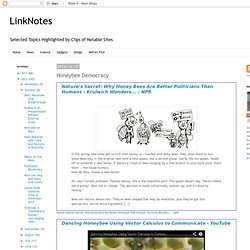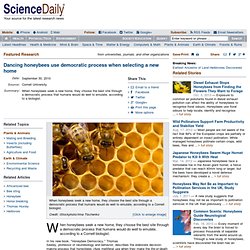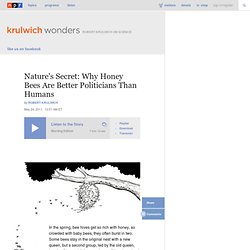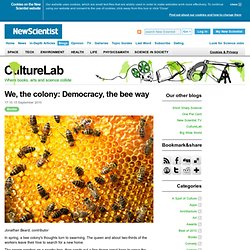

Honeybee Democracy. Nature's Secret: Why Honey Bees Are Better Politicians Than Humans : Krulwich Wonders... : NPR.

Dancing honeybees use democratic process when selecting a new home. When honeybees seek a new home, they choose the best site through a democratic process that humans would do well to emulate, according to a Cornell biologist.

In his new book, "Honeybee Democracy," Thomas Seeley, professor of neurobiology and behavior, describes the elaborate decision-making process that honeybees (Apis mellifera) use when they make the life-or-death choice of a new nesting cavity. When a hive becomes overpopulated, two-thirds of the worker bees and the old queen leave and gather on a nearby branch. Over the next few days, several hundred scout bees search out 10 to 20 potential sites in hollow trees. Meanwhile back at the swarm, each site gets announced with a dance. "A scout adjusts how long she dances according to the goodness of the site," said Seeley. In turn, other scouts inspect the sites and return to dance for themselves. The bee's decision-making process is similar to how neurons work to make decisions in primate brains, Seeley says. Nature's Secret: Why Honey Bees Are Better Politicians Than Humans : Krulwich Wonders...
In the spring, bee hives get so rich with honey, so crowded with baby bees, they often burst in two.

Some bees stay in the original nest with a new queen, but a second group, led by the old queen, heads off to establish a new home. Dancing Honeybee Using Vector Calculus to Communicate. What Honeybees Can Teach Us About Democracy. Thomas D Seeley. My scientific work has primarily focused on understanding the phenomenon of swarm intelligence (SI): the solving of cognitive problems by a group of individuals who pool their knowledge and process it through social interactions.

It has long been recognized that a group of animals, relative to a solitary individual, can do such things as capture large prey more easily and counter predators more effectively. More recently it has been realized that a group of animals, with the right organization, can also solve cognitive problems with an ability that far exceeds the cognitive ability of any single animal.
Thus SI is a means whereby a group can overcome some of the cognitive limitations of its members. SI is a rapidly developing topic that has been investigated mainly in social insects (ants, termites, social wasps, and social bees) but has relevance to other animals, including humans. 1) diversity of knowledge about the available options, Dr. Short CV Publication List Courses Taught. We, the colony: Democracy, the bee way. Jonathan Beard, contributor In spring, a bee colony's thoughts turn to swarming.

The queen and about two-thirds of the workers leave their hive to search for a new home. The swarm perches on a nearby tree, then sends out a few dozen scout bees to scour the neighbourhood. Their job is to find, measure and evaluate every hollow tree or other enclosed space. Tom Seeley: Honeybee Democracy. Seeley, T.D.: Honeybee Democracy. Honeybees make decisions collectively--and democratically.

Every year, faced with the life-or-death problem of choosing and traveling to a new home, honeybees stake everything on a process that includes collective fact-finding, vigorous debate, and consensus building. In fact, as world-renowned animal behaviorist Thomas Seeley reveals, these incredible insects have much to teach us when it comes to collective wisdom and effective decision making. A remarkable and richly illustrated account of scientific discovery, Honeybee Democracy brings together, for the first time, decades of Seeley's pioneering research to tell the amazing story of house hunting and democratic debate among the honeybees. In the late spring and early summer, as a bee colony becomes overcrowded, a third of the hive stays behind and rears a new queen, while a swarm of thousands departs with the old queen to produce a daughter colony.
Review: "Dr. "[S]plendid. " Bee learning and communication. Honey bees have been shown to have a wide range of cognitive skills.

They are sensitive to odors (including pheromones), tastes, and colors, including ultraviolet. They learn such things as color discriminations through classical and operant conditioning and retain this information for several days at least; they communicate the location and nature of sources of food; they adjust their foraging to the times at which food is available; they may even form cognitive maps of their surroundings. Learning[edit] Swarming bees require good communication in order to congregate all in the same spot Foragers were trained to enter a simple Y-shaped maze that had been marked at the entrance with a particular color.
Color learning in honeybees[edit] One of the most common ways that honey bees, Apis mellifera, demonstrate associative learning is in the context of color recognition and discrimination tasks. Color discrimination[edit] Figure 1. Color learning rates and preferences[edit] Figure 2. Figure 3. Tales from the Hive. The waggle dance is used to communicate the location of food sources more than 35 yards away.

The dance consists of two loops with a straight run in the middle.